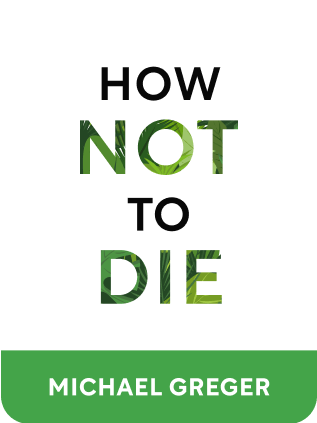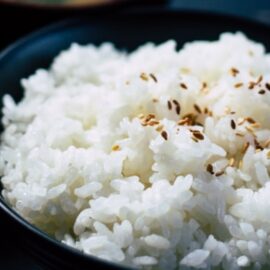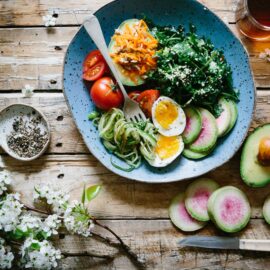

This article is an excerpt from the Shortform book guide to "How Not to Die" by Michael Greger. Shortform has the world's best summaries and analyses of books you should be reading.
Like this article? Sign up for a free trial here .
What is Michael Greger’s How Not to Die about? What one factor, according to the author, can help prevent and reverse most of the modern killer diseases?
In his book How Not to Die, Michael Greger argues that a plant-based, whole-food diet has been scientifically shown to reduce the most common diseases leading to death. Citing thousands of references from scientific literature, Greger covers the top 15 causes of death (from heart disease to Parkinson’s) and describes how diet can reduce each cause of death.
Here is a brief overview of the main points from Michael Greger’s book How Not to Die: Discover the Foods Scientifically Proven to Prevent and Reverse Disease.
How Not to Die: Discover the Foods Scientifically Proven to Prevent and Reverse Disease
In his book How Not to Die, Michael Greger sheds light on the major cause of most deadly diseases: diet—specifically, a diet heavy in meat, dairy, eggs, and processed food. Further, he argues that eating a primarily plant-based diet can prevent and even reverse disease.
Here’s some evidence of how plant-based diets increase health:
- People who used to be vegetarians but who went back to eating meat increased their risk of disease significantly—they increase heart disease odds by 146%, stroke by 152%, diabetes by 166%, weight gain by 231%. Their life expectancy drops by 3.6 years.
- Women who eat more whole plant foods reduce odds of breast cancer by 90%.
In total, lifestyle accounts for 78% of risk of chronic disease. Not smoking, having normal body weight, exercising half an hour a day, and maintaining a healthy diet can reduce the risk of chronic disease by a huge margin.
A plant-based, whole-food diet has been shown to decrease your likelihood of getting a large panel of diseases, from heart disease to Alzheimer’s. Here’s a selection of the many research results cited in the book:
- Drinking 3-4 shots of kale juice a day over 3 months lowers bad LDL cholesterol and boosts HDL cholesterol as much as running 300 miles does.
- Increasing fiber by 7 grams/day reduces risk of stroke by 7%. For the maximum reduction in stroke risk, eat 25 grams/day of soluble fiber and 47 grams/day of insoluble fiber.
- The more plant-based foods you eat, the lower your hypertension rates. Flexitarians show 23% reduced risk of hypertension; vegans show 75% reduced risk.
- Japanese men showed a 25x increase in prostate cancer risk after World War II. This is also associated with a 7x, 9x, and 20x increase in egg, meat, and dairy consumption respectively.
- Premenopausal women who ate 6g of fiber a day had 62% lower odds of breast cancer, compared to those eating <4g a day.
Diet can reverse disease, not just halt it. It’s not too late if you already have heart disease or diabetes. Studies have shown that switching to a plant-based diet can reverse atherosclerotic plaques, reverse the influence of smoking on lung cancer, and decrease the inflammation that leads to many cancers.
Preventing disease is better than treating it. Drugs have side effects, and some disease is irreversible
Nuances to Plant Diets and What We Eat
Why does a plant-based diet improve health? Humans evolved over millions of years eating primarily vegetables, so many of our biological responses to food were wired to prehistoric diets.
Today’s modern environment is unnatural, in the sense that we haven’t evolved to handle the new types of food available to us, as well as the quantity available.
- Processed foods now contain much more fat, sodium, and caloric density than we evolved eating. Our normal biological processes haven’t adapted to surviving on modern diets.
- Modern foods are so nutrient dense that they amplify the dopamine reward circuit. After eating ice cream, ordinary mangos are nowhere near as enjoyable. By eating whole foods, you can reset this sensitivity.
Regulation of food is often strongly influenced by industry. Just like how the tobacco industry fought to show smoking didn’t cause cancer, there is a strong agriculture lobby promoting meat and processed foods.
Why Plants Help and Meat Hurts
Meat itself seems negatively correlated with health and mortality, even controlling for vegetable intake. In other words, if group 1 eats vegetables, and group 2 eats the same amount of vegetables but adds meat, group 2 shows higher mortality and risk of disease.
In these research studies, are vegetarians healthier simply because they tend to be skinnier? No—in population studies, plant-based diets show lower mortality even controlling for BMI, wealth, and other confounding factors.
In research studies, eating health supplements doesn’t have as positive an effect as whole foods. This might be because whole foods contain many other benefits, such as fiber and other micronutrients. Supplement extracts also introduce risk of contaminants and toxicity.
Even More Reasons to Eat Vegetables and Fruit
Think of your diet everyday as a bank account of 2000 calories you can spend everyday. Eating one 800 calorie hamburger displaces eating 7 sweet potatoes or 26 cups of broccoli. Which one would benefit your body more?
Some might shy away from a plant-based diet because it seems expensive. This is partly true—on a calories-per-dollar basis, junk food and fat are the cheapest. But on a nutrients-per-dollar basis, vegetables offer 6x more nutrition compared to processed food.
- Meat costs 3x more than vegetables but deliver 16x less nutrition. Thus, meat is 48x more expensive on a nutrient basis than vegetables.
Diet by Traffic Light
Eating a plant-based diet doesn’t have to be complicated. Michael Greger suggests thinking of food as a traffic light system:
Green Foods: Unprocessed plant foods
- Unprocessed means nothing bad is added, and nothing good is taken away.
- Sometimes, processing actually makes food healthier. Tomato juice may be healthier than whole fruit because the nutrient lycopene is more available. Similarly, cocoa powder is processed to remove saturated fat.
- You can eat unlimited amounts of green foods.
Yellow Foods: Processed plant foods, Unprocessed animal foods
- Processed means something bad is added, or something good is taken away.
- For example, almond milk is worse than eating pure almonds.
- Ideally you’d replace yellow foods with their corresponding green foods, which are more nutritious.
Red Foods: Ultra-processed plant foods, Processed animal foods
- Eat red foods sparingly. In driving, you might run a red light once in a while, but you don’t make a habit of it. The same is true of red foods.
- It’s OK to eat these in small amounts, if they help you eat more green foods (such as bacon bits or hot sauce with vegetables).
Dr. Greger’s Daily Dozen
As a simple checklist for what to eat everyday, Dr. Greger recommends these 12 components. Each box represents one serving.
- Beans: 3 Servings
- Berries: 1 Serving
- Other Fruits: 3 Servings
- Cruciferous Vegetables: 1 Serving
- Greens: 2 Servings
- Other Vegetables: 2 Servings
- Flaxseeds: 1 Serving
- Nuts: 1 Serving
- Spices: 1 Serving
- Whole Grains: 3 Servings
- Beverages: 5 Servings
- Exercise: 1 Serving
These 12 recommendations form “Dr. Greger’s Daily Dozen.”

———End of Preview———
Like what you just read? Read the rest of the world's best book summary and analysis of Michael Greger's "How Not to Die" at Shortform .
Here's what you'll find in our full How Not to Die summary :
- The health benefits of a plant-based, whole-food diet
- How to reduce your risk of developing the most common diseases that can kill you
- The 12 foods you should eat daily to maximize health benefits






